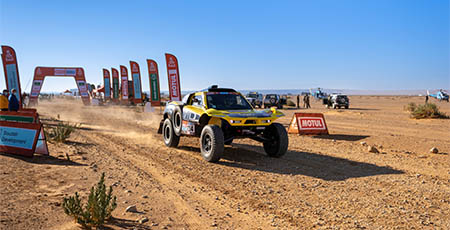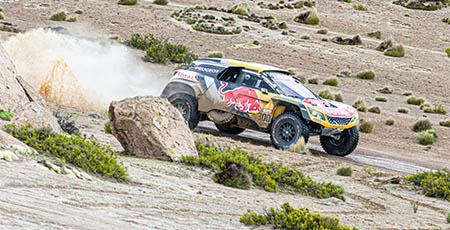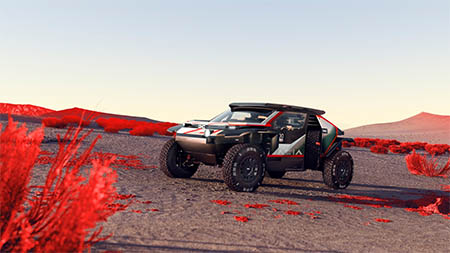
The Grand Tour is roaring back onto our screens, this time tackling the legendary Dakar Rally in their own, hilariously chaotic way. But before Jeremy, James, and Richard unleash their automotive mayhem on the unforgiving landscape, let’s rewind the clock and delve into the rich, rugged history of the “world’s toughest race.”
From its humble beginnings as a gruelling Paris-Dakar trek in 1978, the Dakar Rally has morphed into a global phenomenon, pushing competitors and machines to their absolute limits. Imagine a time when rugged roads were the norm, navigation relied on a compass and grit, and competitors were a fearless motley crew of adventurers, not million-dollar teams. That’s the Paris-Dakar Rally’s origin story, a brutal test of humans and machines traversing continents from Paris to Dakar, Senegal.
We’ll be navigating the sands of time, exploring iconic moments of triumph and disaster, legendary champions, and the death-defying challenges that have cemented the Dakar’s place in motorsports lore. So, let’s peel back the layers and explore its fascinating evolution.
What is the Dakar Rally?
The Dakar Rally race is an annual off-road endurance event that captivates adventurers, motorsport enthusiasts, and thrill-seekers alike. Originating in 1978, it was initially known as the Paris-Dakar Rally, reflecting its original Paris-Dakar Rally route from Paris, France, to Dakar, Senegal. However, due to security concerns in Africa, the rally moved to South America in 2009 before moving to the Middle East in 2020.
The Dakar Rally distance covers thousands of kilometres across challenging terrains, including deserts, mountains, and forests, testing the skills, stamina, and determination of its participants. It encompasses various categories, including cars, trucks, motorcycles, and quads, each competing to conquer the gruelling landscapes and appear victorious. With its rich history, daunting obstacles, and spirit of adventure, the Dakar Rally remains a premier event in the world of motorsport, highlighting the relentless pursuit of excellence and the indomitable human spirit.
How does the Dakar Rally work?
The Dakar Rally isn’t your typical race. Each day features a “stage” with at least one gruelling “special stage” – hundreds of kilometres of off-road, trackless terrain. Competitors race against the clock, navigating with road books and relying on their skills and intuition. Points are awarded based on the special stage times, with penalties for speeding or getting lost.
But the Dakar isn’t just about speed. It’s a marathon, requiring competitors to be self-sufficient. They must repair their own vehicles at night, with limited assistance allowed only during a designated “rest day.”
This unique format pushes competitors to their physical and mental limits, assessing their ability to adapt, solve problems, and persevere amidst the unforgiving terrain and unpredictable challenges. So, while speed matters, it’s the combination of navigation, resourcefulness, and endurance that truly determines who emerges victorious from the Dakar car rally.
How long is the Dakar Rally?
The Dakar Rally’s length can vary depending on the year and location. Traditionally, the Dakar Rally route spanned around 10,000 kilometres, but modern editions tend to be shorter, typically ranging from 5,000 to 8,000 kilometres. These distances are further divided into daily “stages,” which themselves consist of liaison sections on public roads and competitive “special stages” on off-road terrain. The special stages are the heart of the competition and can range from a few hundred kilometres to a demanding 800+ kilometres in extreme cases.
Therefore, the exact duration of the rally isn’t defined by a single number but rather by the combined distance of all stages and the time taken to complete them. Typically, the Dakar Rally can last around 10 to 15 days, with competitors facing a new set of challenges each day.

Winners of the Dakar Rally
1. 1979: Hubert Auriol, Motorcycle (Yamaha XT500) – Paris, France to Dakar, Senegal
The inaugural Dakar saw French motorcycle legend Hubert Auriol claim victory on a Yamaha XT500, setting the stage for the rally’s adventurous future.
2. 1987: Ari Vatanen, Car (Peugeot 205 T16) – Paris, France to Dakar, Senegal
The iconic “Flying Finn” Ari Vatanen dominated in a specially built Peugeot 205 T16, displaying the growing technological advancements in the car category.
3. 1997: Stéphane Peterhansel, Motorcycle (Yamaha YZE850T) – Saint-Louis, Senegal to Dakar, Senegal
The “Monsieur Dakar” began his reign with his first motorcycle victory on a Yamaha YZE850T, paving the way for six more wins across both bikes and cars.
4. 2004: Nani Roma, Motorcycle (KTM LC4 660R) – Clermont-Ferrand, France to Dakar, Senegal
Spanish rider Nani Roma took home the title on a KTM LC4 660R, marking the start of KTM’s long-lasting dominance in the motorcycle category.
5. 2010: Carlos Sainz, Car (Volkswagen Race Touareg 2) – Buenos Aires, Argentina to Buenos Aires, Argentina
Rally legend Carlos Sainz secured his first Dakar win in a Volkswagen Race Touareg 2, highlighting the growing prominence of SUVs in the car category.
6. 2016: Stéphane Peterhansel, Car (Peugeot 2008 DKR) – Buenos Aires, Argentina to Rosario, Argentina
The “Monsieur Dakar” added another victory to his legacy, this time behind the wheel of a Peugeot 2008 DKR, highlighting his versatility across different vehicles.
7. 2019: Nasser Al-Attiyah, Car (Toyota Hilux Overdrive) – Lima, Peru to Lima, Peru
Qatari driver Nasser Al-Attiyah secured his third Dakar win (across different manufacturers) in a Toyota Hilux Overdrive, solidifying Toyota’s presence in the modern era.
8. 2023: Kevin Benavides, Motorcycle (Honda CRF450 Rally) – Hail, Saudi Arabia to Dammam, Saudi Arabia
Argentinean rider Kevin Benavides claimed his second Dakar victory on a Honda CRF450 Rally, showcasing the enduring spirit of motorcycle competition.
9. 2023: Vaidotas Žala, Lightweight Prototype (Red Bull Off-Road Team by Óscar Fuertes) – Hail, Saudi Arabia to Dammam, Saudi Arabia
Lithuanian driver Vaidotas Žala emerged victorious in the Lightweight Prototype category with a Red Bull Off-Road Team by Óscar Fuertes vehicle, representing the rise of new players.
10. 2023: Kamaz Master (Dmitry Sotnikov) – Hail, Saudi Arabia to Dammam, Saudi Arabia
The Russian Kamaz Master team continued their dominance in the truck category, with Dmitry Sotnikov securing his fourth Dakar victory.
Dakar Rally 2024
The 2024 Dakar Rally, held from January 5th to 19th, saw another chapter unfold in the epic history of the race. Taking place entirely within Saudi Arabia for the fifth time, it offered 5,000 kilometres of demanding special stages across diverse landscapes, including the iconic “Empty Quarter” desert.
Experienced champions like Ricky Brabec and Carlos Sainz reigned supreme in the motorcycle and car categories respectively, showcasing their mastery of navigation and endurance. However, new stars also appeared, with Kevin Benavides claiming his second motorcycle victory and Toby Price displaying immense determination despite finishing just shy of the podium.
The rally also saw technological advancements take centre stage, with electric and hydrogen-powered vehicles participating for the first time, marking a potential shift towards a more sustainable future for the Dakar.
Where to watch the Dakar rally
As the rally has been and gone, there are some great clips online to catch up. Why not take a look at the 2024 behind-the-scenes special?

Dacia to Take on the Dakar Rally 2025
In its ongoing endeavour to redefine the fundamentals, Dacia, the brand imbued with an outdoor ethos, is set to participate in the Dakar Rally and the World-Rally Raid Championship (W2RC) starting from 2025. Venturing onto some of the planet’s most challenging and unforgiving terrains, Dacia unveils its contender, the Sandrider, a prototype crafted for victory.
Derived from the Manifesto concept car, Dacia’s hub for innovative ideas unveiled in 2022, the Sandrider emerges as a completely new vehicle meticulously tailored for rally-raids. It leverages the racing prowess of the Renault Group and Prodrive, a UK-based firm renowned for its motorsport expertise.
True to Dacia’s renowned ethos, the Sandrider prioritises the essentials of motorsport: performance and triumph. This groundbreaking prototype astutely harnesses all the opportunities presented by regulations in the Ultimate T1+ category, with a focus on agility and minimal weight. It adeptly caters to the fundamental requirements of both drivers and co-drivers, who actively contributed to its development from inception. Throughout the project’s inception and leading up to numerous testing sessions, drivers and co-drivers shared their wealth of experience and insights with designers and engineers, primarily through immersive design sessions utilising virtual reality.
While the Sandrider stands as a distinctively unique Dacia, it remains firmly aligned with the brand’s intrinsic values.
Dakar Rally vs. The Grand Tour
So, we’ve traversed the dusty dunes of Dakar history, witnessed legendary triumphs, and braced ourselves for the impending Grand Tour adventure. The question now looms: will the boys from Clarkson, Hammond & May conquer the Dakar, or will the Dakar conquer them?
One thing’s for certain: their foray into this gruelling test of endurance promises a spectacle unlike any other. Their signature blend of humour, bravado, and mechanical mayhem could rewrite the Dakar narrative, injecting a dose of comedic chaos into the world’s toughest race. But underestimate the Dakar at your peril. It’s a crucible that humbles even the most seasoned petrolhead, demanding skill, strategy, and unwavering resilience.
So, sit back, grab your popcorn (or maybe some engine oil), and prepare to be entertained. Will Jeremy’s Napoleonic delusions of grandeur lead to spectacular failure? Will James’ meticulous planning be undone by Richard’s impulsive tinkering? Could the Dakar desert rally forge an unlikely bond between them, or will their competitive spirits drive them apart? Let us know your thoughts if you watch the show!